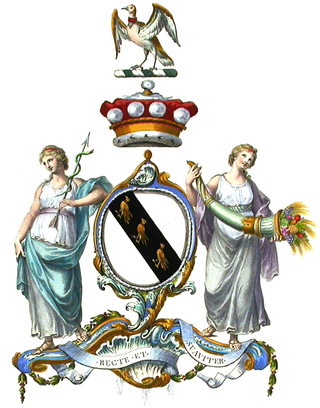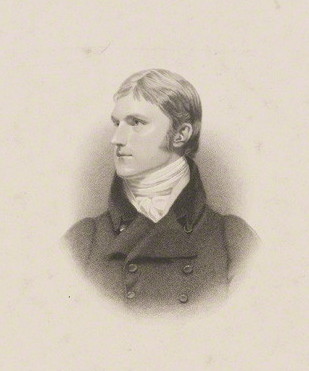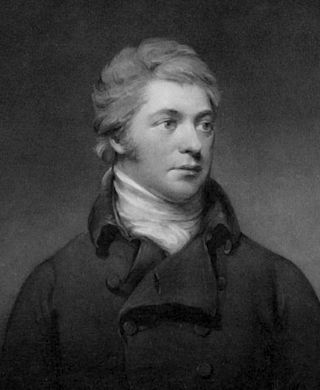The Peerage of the United Kingdom is one of the five Peerages in the United Kingdom. It comprises most peerages created in the United Kingdom of Great Britain and Ireland after the Acts of Union in 1801, when it replaced the Peerage of Great Britain. New peers continued to be created in the Peerage of Ireland until 1898.

Earl of Harewood, in the County of York, is a title in the Peerage of the United Kingdom.

Earl Cathcart is a title in the Peerage of the United Kingdom.

Earl of Dudley, of Dudley Castle in the County of Stafford, is a title that has been created twice in the Peerage of the United Kingdom, both times for members of the Ward family.

Viscount Massereene is a title in the Peerage of Ireland. It was created in 1660, along with the subsidiary title of Baron Loughneagh. From 1665 to 1816 the Skeffington Baronetcy of Fisherwick was attached to the viscountcy and from 1756 to 1816 the Viscounts also held the title of Earl of Massereene. Since 1843 the peerages are united with titles of Viscount Ferrard, of Oriel and Baron Oriel, both in the Peerage of Ireland, and Baron Oriel, in the Peerage of the United Kingdom. The Viscount also holds the subsidiary titles of Baron Loughneagh (1660) and Baron Oriel (1790) in the Peerage of Ireland and Baron Oriel (1821) in the Peerage of the United Kingdom. As Baron Oriel, he sat in the House of Lords until 1999.

Viscount Scarsdale, of Scarsdale in Derbyshire, is a title in the Peerage of the United Kingdom. It was created in 1911 for the prominent Conservative politician and former Viceroy of India George Curzon, 1st Baron Curzon of Kedleston, who was created Earl Curzon of Kedleston at the same time and was later made Marquess Curzon of Kedleston.

Marquess of Ripon, in the County of York, was a title in the Peerage of the United Kingdom. It was created in 1871 for the Liberal politician George Robinson, 2nd Earl of Ripon.

Stratford Canning, 1st Viscount Stratford de Redcliffe, was a British diplomat who became best known as the longtime British Ambassador to the Ottoman Empire. A cousin of George Canning, he served as Envoy Extraordinary and Minister-Plenipotentiary to the United States of America between 1820 and 1824 and held his first appointment as Ambassador to the Ottoman Empire between 1825 and 1828.
(George Frederick) D'Arcy Lambton, 2nd Earl of Durham, styled Viscount Lambton from 1833 to 1840, was a British peer.
Joan Canning, 1st Viscountess Canning was the wife of British prime minister George Canning.

Baron Garvagh, of Garvagh in the County Londonderry, is a title in the Peerage of Ireland. It was created in 1818 for George Canning. He had previously represented Sligo and Petersfield in Parliament and also served as Lord Lieutenant of County Londonderry. Canning was the first cousin of both Prime Minister George Canning and the diplomat Stratford Canning, 1st Viscount Stratford de Redcliffe. The title is currently held by his great-great-great-grandson, the sixth Baron, who succeeded his father in 2013.
Canning is a method of preserving food in which the food contents are processed and sealed in an airtight container.

George Canning, 1st Baron Garvagh FRS was an Anglo-Irish Member of Parliament.

Thomas Wallace, 1st Baron Wallace, PC, FRSE was an English politician and peer.
John Ward, 1st Viscount Dudley and Ward, known as John Ward until 1740 and as the 6th Baron Ward from 1740 to 1763, was a British Tory politician who sat in the House of Commons from 1727 to 1734.
Thomas Henry Skeffington, 2nd Viscount Ferrard, styled The Honourable from 1790 until 1824, was an Irish peer and politician.

The House of Stratford is a British aristocratic family, originating in Stratford-on-Avon between the eleventh and thirteenth centuries. The family has produced multiple titles, including Earl of Aldborough, Viscount Amiens, Baron Baltinglass, Viscount Stratford de Redcliffe and the Dugdale Baronets. The Viscount Powerscourt and Baron Wrottesley both claim descent from this House. Historic seats have included Farmcote Manor and Stratford Park in Gloucester, Merevale Hall in Warwickshire, Baltinglass Castle, Belan and Aldborough House in Ireland, and Stratford House in London, amongst many others. The house was at its most powerful in the fourteenth, sixteenth, and eighteenth centuries.
Villiers is an aristocratic family in the United Kingdom. Over time, various members of the Villiers family were made knights, baronets, and peers. Peerages held by the Villiers family include the dukedoms of Buckingham (1623–1687) and Cleveland (1670–1709), as well as the earldoms of Anglesey (1623–1661), Jersey, and Clarendon. Perhaps the most prominent members of the family were those who received the two dukedoms: George Villiers, 1st Duke of Buckingham (1592–1628) rose to fame and influence as favourite of King James I of England, while Barbara Villiers, Duchess of Cleveland (1640–1709) became a mistress of King Charles II of England, by whom she had five children.









